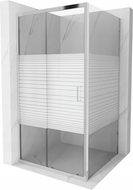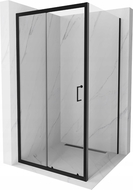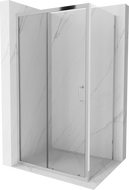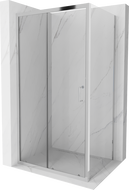
The bathroom is a place with almost constant humidity and high temperature, and every bath leaves a residue of water and soap, making cleaning a shower enclosure seem difficult. How to properly clean a shower enclosure? This is a question everyone with such a fixture in their bathroom asks themselves.
We suggest what to do to make the enclosure shine with cleanliness. Check how to effectively remove stains and limescale, clean hard-to-reach places, and ensure regular cleaning of the shower enclosure, so it looks new for as long as possible.
What will you learn from this article?
Before you start removing dirt and cleaning the shower enclosure, think carefully about how to do it quickly and easily. The following article will help you with that! From this reading, you will learn, among other things:
why regular cleaning of the shower enclosure is so important,
how to remove limescale and tough stains without scratching the surface of the enclosure,
how to clean the shower so it looks new,
about strong cleaning agents and natural cleaning methods.
Regular cleaning of the shower enclosure is the key to success
Let's start by saying that the shower enclosure should be cleaned regularly: this will help avoid situations where soap scum and hard water deposits become really difficult to remove. Furthermore, shower trays and enclosures have many hard-to-reach nooks where bacteria can develop, especially since the bathroom is a humid and quite warm room.
Let’s clearly repeat the headline above: the key to success with a shower enclosure is regular cleaning — whether through home methods or chemical cleaners.
The most important thing is the mentioned regularity, which will ensure a great appearance of the enclosure for many years, but also save us effort: contrary to appearances, regular and quick cleaning of the enclosure is much less labor-intensive than attempting to clean dried residue and limescale.
Regular shower cleaning in practice
It’s good — as much as possible — to take care of the enclosure after every bath. Using a water squeegee and a microfiber cloth, dry the surface of the door of the enclosure, which will prevent streaks and moisture from lingering. But how to clean an enclosure with a tray? Here we mainly have two solutions to choose from: eco-friendly, home methods, and classical chemicals.
Learn how to clean the trap in the tray and linear drain.
In sum, we clean the enclosure after every bath using:
a water squeegee,
soft microfiber cloths.
Thorough cleaning is then done using:
eco-friendly agents and home methods,
chemical liquids intended for the bathroom.
And speaking of how to remove limescale and other contaminants from the bathroom, also check how to care for the grout in this room.
Home methods for cleaning the shower enclosure
Many people are surely familiar with one of the most popular home methods for cleaning the enclosure, which is using food products.
Vinegar is primarily used for this purpose, which effectively tackles lime deposits left by 'hard water,' but lemon, citric acid, hydrogen peroxide, and baking powder also have their uses in cleaning the enclosure.
Cleaning the shower enclosure with vinegar
In tougher cases, you can use plain vinegar, for regular cleaning, a 1:1 solution with clean water is sufficient. A small, household sprayer is often used here (e.g., for plants), which allows for the rapid application of vinegar or its solution onto the walls of the enclosure. Then you need to leave the solution on for about an hour. After this time, wash the walls of the enclosure with a sponge or brush and rinse the entire surface thoroughly with water.
Popular and effective mixture of vinegar and baking soda
To remove stains, you can also use a vinegar and baking soda solution: spread the resulting paste over the most stained areas, as well as on fittings and grout or areas by the wheels of the enclosure walls. This mixture handles residue and limescale excellently — for hard-to-reach places, it's good to use an old toothbrush with soft bristles for cleaning. After cleaning, simply rinse off the vinegar and soda residues thoroughly with gently warm water.
Lemon juice for cleaning the shower enclosure
The effectiveness of lemon juice may be slightly less than vinegar, but thanks to its properties, it allows the removal of scale buildup on the enclosure walls. Simply spray the enclosure with the juice, wait a few minutes, then wipe the sprayed surfaces with a cloth or soft sponge. Let's not forget that an added benefit of such eco-friendly cleaning is a pleasant scent in the shower.
Natural cleaning agents you surely have at home
The recommended home methods for cleaning the shower enclosure are effective, though relatively time-consuming. By opting for this type of care for our enclosure, we will be using:
vinegar,
a combination of vinegar and baking soda,
lemon juice.
Household chemicals
Today, in practically every store, we find products for cleaning dirty surfaces, including those specifically for cleaning shower enclosures. Classic cleaning agents will work in cases where home solutions do not handle the dirt. Moreover, using them makes cleaning simply easier and quicker: they are just stronger than vinegar and soda. Some products are meant for general bathroom cleaning, others specifically for plastic or glass surfaces of the enclosure. In this case, you can also just use a liquid window cleaner: it handles residue and limescale just as well.
Additionally, for cleaning the shower enclosure (as well as fittings and tiles), dishwashing liquid will work well too. This is a good option for people who are sensitive to standard chemical products. Dishwashing liquid effectively handles soap scum and old stains, as long as we haven't let the enclosure's surface become truly thick with them.
When cleaning glass or plastic walls of the shower enclosure, avoid abrasive preparations containing microgranules. This includes powders and creams that can scratch the surface. Also, avoid rough sponges with abrasive layers, which can damage tempered glass where stubborn limescale usually accumulates. And if you're just setting up a bathroom, check how to choose the perfect shower enclosure.
What are the advantages of strong bathroom cleaning agents?
they handle bigger stains effectively,
cleaning takes less time than with ecological methods.
Do chemical cleaning agents for shower enclosures have drawbacks?
Of course, they do! However, to minimize their potential harm and not damage the enclosure surface, avoid abrasive agents like powders or creams, as they can scratch the walls of the enclosure. Sometimes it's worth using the ordinary dishwashing liquid previously mentioned, which can deal even with light limescale, instead of more aggressive products.
Prevention - the recipe for a clean shower enclosure
Wanting to take even better care of your shower enclosure and bathroom cleaning, not only for aesthetic but also hygiene reasons, it's good to invest in a hydrophobic coating. Such a coating contains various substances that smooth the glass surface, thus repelling water in a certain way. Water that runs down the walls of the enclosure coated with a hydrophobic layer doesn’t form into drops, which prevents individual streaks.
Moreover, applying a hydrophobic coating also makes cleaning a shower tray enclosure easier: it avoids streaks as well as the buildup of soap and limescale. Such a coating can be used on both glass and plastic enclosures, and it is available from reputable brands. This is a good solution for people who value convenience and time savings during cleaning.
Ensure regular care of your shower enclosure
Now you know how to clean a shower, as well as what to clean the entire enclosure with, so it can look impeccable again. We have described the most popular methods and cleaning agents, thanks to which your bathroom will be properly clean and well-maintained.


























